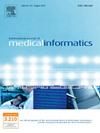支持多重疾病自我管理的数字应用:范围审查
IF 3.7
2区 医学
Q2 COMPUTER SCIENCE, INFORMATION SYSTEMS
International Journal of Medical Informatics
Pub Date : 2025-05-20
DOI:10.1016/j.ijmedinf.2025.105988
引用次数: 0
摘要
多病,定义为两种或两种以上长期疾病的共同发生,正在迅速增加,并对卫生保健系统构成挑战。数字技术的进步提供了解决方案,促进了个性化、可扩展的护理干预措施,使个人能够更有效地管理自己的病情。这些应用程序有可能改善获得护理的机会,提高患者参与度,并支持量身定制的自我管理方法。目的:本综述的目的是综合目前的证据,使用数字应用程序的自我管理在成人多病。方法系统检索PubMed、Web of Science、OVID、CINAHL、EMBASE等文献,并辅以人工检索。使用布尔运算符和目标关键词检索从数据库建立到2024年1月16日的相关研究。结果共检索到文献1974篇,其中31篇符合纳入标准。数字应用于多重疾病的自我管理表现出高度的可接受性和不同的疗效。主要的好处包括改进了通信、症状跟踪和自主权。障碍包括隐私问题、额外的患者负担和参与挑战。社会人口统计学、自我效能感和数字素养对工具使用的障碍和促进因素都有影响。支撑数字应用的理论模型是有限的。老年人和工作年龄人口很少被包括在内。结论目前的证据基础并不能完全满足低数字素养的老年人或有多种疾病的工作年龄人群的需求。我们的模型强调了更广泛的上下文机制在数字工具采用中的重要性。未来的研究应优先考虑理论驱动的工具开发,为疾病集群量身定制,并与社会人口统计学概况、健康风险和社会护理需求保持一致。解决这些差距可以改善高风险人群的自我管理和健康结果。本文章由计算机程序翻译,如有差异,请以英文原文为准。
Digital applications to support self-management of multimorbidity: A scoping review
Introduction
Multimorbidity, defined as the co-occurrence of two or more long-term conditions, is increasing rapidly and poses challenges for healthcare systems. Advances in digital technologies offer solutions by facilitating personalised, scalable care interventions that empower individuals to manage their conditions more effectively. These applications have potential to improve access to care, enhance patient engagement, and support tailored approaches to self-management.
Objectives
This scoping review aims to synthesise current evidence on the use of digital applications for self-management in adults with multimorbidity.
Methods
A scoping review was conducted, systematically searching PubMed, Web of Science, OVID, CINAHL, EMBASE, and additional manual searches. Boolean operators and targeted key terms were employed to retrieve relevant studies from database inception to 16th January 2024.
Results
The search yielded 1,974 articles, of which 31 met the inclusion criteria. Digital applications for self-management in multimorbidity demonstrated high acceptability and varying efficacy. Key benefits included improved communication, symptom tracking, and autonomy. Barriers included privacy concerns, additional patient burden, and engagement challenges. Socio-demographics, self-efficacy, and digital literacy influenced both barriers and facilitators to tool usage. Theoretical models underpinning digital applications were limited. Older adults and the working-age population were rarely included.
Conclusion
The current evidence base does not fully address the needs of older adults with low digital literacy or working-age populations with multimorbidity. Our model highlights the importance of broader contextual mechanisms in digital tool adoption. Future research should prioritise theory-driven tool development tailored to disease clusters and aligned with sociodemographic profiles, health risks, and social care needs. Addressing these gaps could improve self-management and health outcomes for high-risk populations.
求助全文
通过发布文献求助,成功后即可免费获取论文全文。
去求助
来源期刊

International Journal of Medical Informatics
医学-计算机:信息系统
CiteScore
8.90
自引率
4.10%
发文量
217
审稿时长
42 days
期刊介绍:
International Journal of Medical Informatics provides an international medium for dissemination of original results and interpretative reviews concerning the field of medical informatics. The Journal emphasizes the evaluation of systems in healthcare settings.
The scope of journal covers:
Information systems, including national or international registration systems, hospital information systems, departmental and/or physician''s office systems, document handling systems, electronic medical record systems, standardization, systems integration etc.;
Computer-aided medical decision support systems using heuristic, algorithmic and/or statistical methods as exemplified in decision theory, protocol development, artificial intelligence, etc.
Educational computer based programs pertaining to medical informatics or medicine in general;
Organizational, economic, social, clinical impact, ethical and cost-benefit aspects of IT applications in health care.
 求助内容:
求助内容: 应助结果提醒方式:
应助结果提醒方式:


